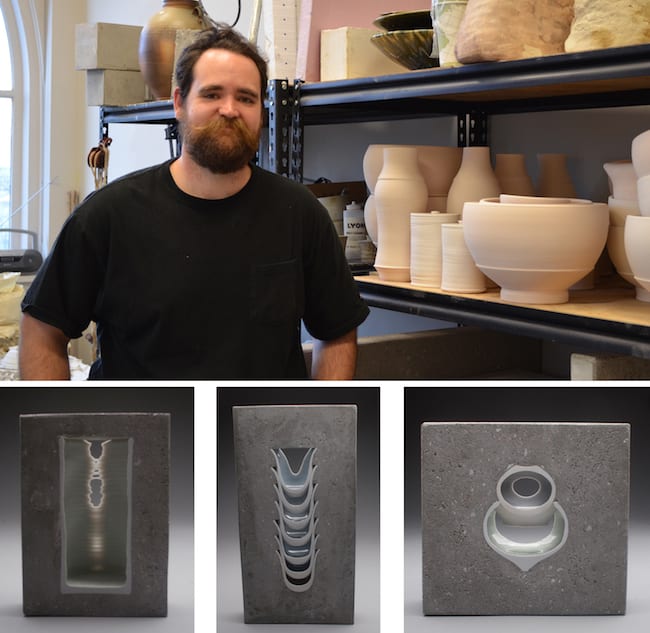Thomas Lowell Edwards recently received his Masters of Fine Art from University of Nebraska-Lincoln in May 2014. Edwards is a multimedia artist creating sculpture using real pottery in inspiring a dialogue about the diminishing communal activities in our culture within a representational format. He explains that he “began to notice a trend of increasing disengagement in American culture after spending time abroad and observing the amount of time other cultures allotted for meals, coffee, etc. with companions.” Edwards has an exciting conceptual angle, making art about pots, but removed from the object-maker genre, objectively exploring the evolving role of community, pottery, and ultimately, the studio potter.
Above Image: Thomas Lowell Edwards, 2014.
Edwards’ sculptures balance being a real object (a pot and an artifact) and being a representation of the object designed for objective contemplation. The handmade pots, with deep throwing lines and subtle glaze, sensually draw you in and provide an understood human relationship, while the presentation is a jarring shift to an abstract perspective. This balance places the viewer in a disorienting but engaging state of suspended disbelief.

Encapsulating such a fiercely active object as a pot, typically moving from the cabinet; to mouth; to car; to office; to sink, implies that there is no longer a practical need for it. The concrete in the sculptures, an icon of industrialization, has literally halted the handmade pot’s functionality, implying it is now equally as useful incarcerated in a cold block of concrete as it is waiting patiently in your kitchen cabinet. I look at these pots with a helpless feeling of injustice. Not only has the mobility and very soul of this pottery been suppressed, they have been sliced in half for public observation and reflection, like an autopsy in a room full of eager medical students. This relates Edwards’ sculpture to specimens suitable for a science museum intended to enlighten, educate, and elicit a response.
As a current resident at the Bemis Center for Contemporary Art he was recently involved in the execution of a large community dinner in which Edwards produced the dinnerware. He also participated in Cooking on the Square in Cookeville, Tennessee, to benefit the Habitat for Humanity. Edwards’ artistic philosophy addresses community in a full-circle methodology. His sculptures are approachable and lead the viewer on a visually subtle but conceptually powerful path, concluding with a tragic epiphany. He then offers an activist solution to the problem by planning and participating in events that actually bring people, communities, together.
But perhaps what is most striking about this work is that pottery and community dinners are just a metaphorical framework for impacting other declining community activities. Decreased voter turnout, a decline in public protests, declining enrollment in school clubs and sports are all examples of suffering community involvement. Edwards’ art and practice offer an unsuspecting model for inspiring social change across the spectrum of activities in American culture. Behold, the power of pots!

I have two closing points. One is that, as CFile will explore soon, the fastest growing challenge to the ceramics market is coming not from glass or plastic but concrete. This industry is beginning to innovate and expand like never before. They are creating ceramic-seeming surfaces for tiling, brick, building cladding and even the decorative design field where there are concrete vases, lamps and, yes, dinnerware too. So Edwards’ marrying of the two has a no doubt accidental but nonetheless Darwinian resonance. My next point is that there is always concern when a young student is catapulted into the real world with such a perfect and professional concept. It becomes difficult to escape, particularly if there is a strong market response. We can all point to artists who continually reprise their graduate show. This may not apply to Edwards because he is a little older than many graduates and has been at school on and off for a decade. There is no need to change now; his direction is still vital and under-explored but over the long term one hopes that it does not imprison the maker the way it does the pots.
Justin Crowe has joined CFile’s team as writer-at-large and will be reporting from Europe in the coming months.





Thomas Lowell Edwards, Iterations: Graduate Thesis Work, 2014

Thomas Lowell Edwards, Five Espresso, 2014

Thomas Lowell Edwards, Twenty Small Dishes, 2014

Thomas Lowell Edwards, Ten Filled Eleven Empty, 2014

Thomas Lowell Edwards, Ten Filled Eleven Empty (detail), 2014

Thomas Lowell Edwards, Ten Filled Eleven Empty (detail), 2014

Thomas Lowell Edwards, Ten Filled Eleven Empty (detail), 2014

Thomas Lowell Edwards, One Hundred Plates (detail), 2014

Works by Thomas Lowell Edwards. All images by Thomas Lowell Edwards. Images courtesy of the artist.

I see you don’t monetize your blog, don’t waste your traffic, you
can earn extra cash every month because you’ve got hi quality content.
If you want to know how to make extra money,
search for: Boorfe’s tips best adsense alternative
Hi admin, i must say you have high quality articles here.
Your website can go viral. You need initial traffic boost only.
How to get it? Search for; Mertiso’s tips go viral
“…an unsuspecting model for inspiring social change across the spectrum of activities in American culture.”? Really?
Perhaps if the author simply accepted the premise that this work looks fantastic and original (which it does and is) he could have used the available space to help us examine why that it the case. The well conceived proportions and compositions? The elegant contrast of rough concrete and glassy smooth porcelain? The exciting mental kick upon realizing that the those are sliced fragments dinnerware that draw our attention and not arbitrary ceramic forms? The way the common dinnerware expresses elegant and unexpected forms when sliced and dissected?
And finally, maybe the best culturally critical art isn’t “in your face” but simply a great visual statement exemplifying higher cultural goals.